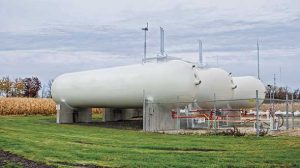Propane’s future in the new age of energy
Throughout the energy world, conversations are taking place about how various forms of renewable energy, combined with abundant natural gas, are being set up to serve as the dominant forces of the future.
Amid all of the talk about wind, solar, lithium-ion batteries and shale-derived natural gas, it’s sometimes easy to ignore one of the industry stalwarts: propane, which very much still has a role to play in meeting the world’s energy needs.
Let’s look at propane’s place and perhaps even stretch our thinking a bit about what may one day come to pass for this particular hydrocarbon liquid.
Propane hasn’t exactly been viewed as a growth industry, certainly not when considering the shifts in the United States population toward areas supplied by natural gas and all of the speculation about fossil fuel alternatives taking over developed economies. However, in recent years, propane has been minding its business, continuing to plug away and seeing its arrow point back upward.
According to a report by ICF, propane demand is estimated to increase to 10.1 billion gallons by 2025, compared with about 9 billion gallons in 2014. If this were to happen, it would amount to a 9.8 percent increase over that span. Although not considered a torrid pace, it’s obviously far better than the alternative – flat, or even worse, lower demand.
However, it’s important to acknowledge that predictions are difficult to make with any accuracy, especially when it comes to a rapidly evolving market, such as energy, or as is the case here, a single natural gas liquid (NGL).
For instance, we have to at least consider the possibility that residential wind or solar will see greater-than-expected growth, contributing to a cap on homeowner demand for propane. It’s also conceivable that even more people will relocate from remote locations that are well served by propane, to cities and suburbs that already supply millions of gas customers.
Alternatively, something entirely out of the ordinary could happen that crimps propane demand. We can’t know with certainty until we get there.
Meanwhile, if demand does grow, propane market participants will have to be cognizant of supply levels, which are ultimately driven by oil and gas production. If those levels get too high and can’t match the demand, prices could be pushed downward.
Let’s return our focus to the ICF estimate. Beyond the headline outlook itself, something of particular interest can be found within the projection – specifically, the idea that we should expect a slow, continuing drop-off in propane demand from its conventional markets. So, what’s going to drive a greater need, then? Potentially, it could be more use of propane in our old friend: the internal combustion engine.
Before we get too far ahead of ourselves, understand that this outlook rests on the assumption that just over 50,000 propane-powered vehicles will be sold annually. We’re not talking about a day when millions of propane cars and trucks are on the roads. But there is an opportunity in commercial fleets, already witnessed, in one instance, with the adoption of propane-powered vehicles operated by UPS.
UPS has made a point of noting the cleaner-burning properties of propane, something that should resonate with environmentally inclined arguments. All one has to do is consider what a masterful job the natural gas industry has done in building up its product as a force for good in meeting global energy demand, and propane might consider talking up its own qualities. It is a derivative, after all, so why not make more noise?
Without question, this isn’t an apples-to-apples comparison. Clearly, natural gas is pulled from the ground to serve a host of purposes. NGLs, such as propane, fall out during processing and get directed toward specific uses. The point is merely that, from a public relations perspective, propane arguably still hasn’t had its time in the spotlight.
Maybe that should change. Because even as the energy market continues to advance, there will always be room for propane.
Michael W. Hinton is the chief strategy and customer officer at Allegro Development Corp. Based in Dallas, Allegro makes commodity trading and risk management software for companies operating in the crude oil, natural gas, utilities and agriculture sectors.

















